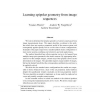Free Online Productivity Tools
i2Speak
i2Symbol
i2OCR
iTex2Img
iWeb2Print
iWeb2Shot
i2Type
iPdf2Split
iPdf2Merge
i2Bopomofo
i2Arabic
i2Style
i2Image
i2PDF
iLatex2Rtf
Sci2ools
CVPR
2003
IEEE
2003
IEEE
Learning epipolar geometry from image sequences
We wish to determine the epipolar geometry of a stereo camera pair from image measurements alone. This paper describes a solution to this problem which does not require a parametric model of the camera system, and consequently applies equally well to a wide class of stereo configurations. Examples in the paper range from a standard pinhole stereo configuration to more exotic systems combining curved mirrors and wide-angle lenses. The method described here allows epipolar curves to be learned from multiple image pairs presented to the stereo cameras. By aggregating information over the multiple images, a dense map of the epipolar curves can be determined on the images. The algorithm requires a large number of images, but has the distinct benefit that the correspondence problem does not have to be explicitly solved. We show that for standard stereo configurations the results are comparable to those obtained from a state of the art parametric model method, despite the significantly weake...
Computer Vision | CVPR 2003 | Parametric Model Method | Standard Pinhole Stereo | Standard Stereo Configurations | Stereo Camera Pair | Stereo Cameras |
| Added | 12 Oct 2009 |
| Updated | 12 Oct 2009 |
| Type | Conference |
| Year | 2003 |
| Where | CVPR |
| Authors | Yonatan Wexler, Andrew W. Fitzgibbon, Andrew Zisserman |
Comments (0)

